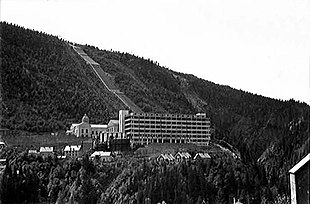Norwegian heavy water sabotage
| Norwegian heavy water sabotage | |||||
|---|---|---|---|---|---|
| Part of World War II | |||||
|
The Vemork Hydroelectric Plant in 1935. The heavy water was produced in the front building (the Hydrogen Production Plant) |
|||||
|
|||||
The Norwegian heavy water sabotage (Bokmål: Tungtvannsaksjonen, Nynorsk: Tungtvassaksjonen) was a series of actions undertaken by Norwegian saboteurs during World War II to prevent the German nuclear energy project from acquiring heavy water (deuterium oxide), which could have been used by the Nazis to produce nuclear weapons. In 1934, at Vemork, Norway, Norsk Hydro built the first commercial plant capable of producing heavy water as a byproduct of fertilizer production. It had a capacity of 12 tonnes (13 short tons) per year. During World War II, the Allies decided to remove the heavy water supply and destroy the heavy water plant in order to inhibit the Nazi development of nuclear weapons. Raids were aimed at the 60 MW Vemork power station at the Rjukan waterfall in Telemark, Norway.
Prior to the German invasion of Norway on 9 April 1940, the Deuxième Bureau (French military intelligence) removed 185 kg (408 lb) of heavy water from the plant in Vemork in then-neutral Norway. The plant's managing director, Aubert, agreed to lend the heavy water to France for the duration of the war. The French transported it secretly to Oslo, to Perth, Scotland, and then to France. The plant remained capable of producing heavy water.
The Allies remained concerned that the occupation forces would use the facility to produce more heavy water for their weapons programme. Between 1940 and 1944, a sequence of sabotage actions, by the Norwegian resistance movement—as well as Allied bombing—ensured the destruction of the plant and the loss of the heavy water produced. These operations—codenamed Grouse, Freshman, and Gunnerside—finally managed to knock the plant out of production in early 1943.
...
Wikipedia

